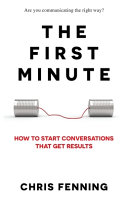

The book emphasizes how the first minute of any interaction can set the tone for the entire relationship. In business, this can mean the difference between sealing a deal or losing a client. The author presents research that shows how quickly people form judgments about others and how these judgments can be difficult to change. By focusing on making a strong, positive impression in the first minute, individuals can enhance their professional relationships and opportunities.
Continue readingThe author discusses the significance of creating a welcoming and positive environment, whether in a meeting, an interview, or a networking event. The first minute is not just about personal presentation; it's also about setting the stage for a comfortable and engaging interaction. Techniques for achieving this include effective body language, a warm greeting, and establishing common ground quickly. The book provides practical tips on how to create an atmosphere that encourages openness and collaboration.
Continue readingStorytelling is highlighted as a powerful tool for making connections in the first minute. The author explains that sharing a brief, relevant story can capture attention and make the speaker more relatable. Stories can illustrate key points, evoke emotions, and help to build rapport with the audience. The book offers guidance on how to craft and deliver impactful stories that resonate within the first minute of interaction.
Continue readingActive listening is presented as a crucial component of effective communication in the first minute. The author explains that listening attentively can enhance understanding and foster a sense of respect and value towards the other person. Techniques for improving active listening include maintaining eye contact, nodding, and paraphrasing what the other person has said. The book emphasizes that by demonstrating genuine interest and engagement, individuals can strengthen their connections and make a lasting impression.
Continue readingThe book delves into the impact of nonverbal cues in the first minute of interaction. Body language, facial expressions, and tone of voice contribute significantly to how messages are received. The author provides insights into how to use nonverbal communication effectively to convey confidence and openness. Understanding the nuances of body language can help individuals navigate social situations with greater ease and effectiveness.
Continue readingThe importance of setting clear intentions before entering any interaction is a key takeaway from the book. The author encourages readers to reflect on their goals and what they hope to achieve in the first minute. By being intentional about the message they want to convey, individuals can communicate more effectively and steer the conversation in a productive direction. The book offers strategies for clarifying intentions and aligning them with desired outcomes.
Continue readingFinally, the book advocates for the idea of continuous improvement in communication skills. The author encourages readers to seek feedback and reflect on their interactions to identify areas for growth. By practicing the techniques discussed in the book, individuals can enhance their ability to make impactful first impressions over time. The book emphasizes that mastering the art of the first minute is an ongoing journey that can lead to significant personal and professional development.
Continue reading